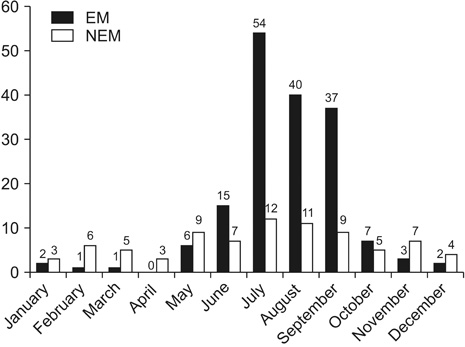Ewha Med J.
2017 Jul;40(3):122-127. 10.12771/emj.2017.40.3.122.
Clinical Characteristics and Epidemiology of Enteroviral Meningitis Compared to Non-Enteroviral Meningitis in Infants under 3 Months of Age
- Affiliations
-
- 1Department of Pediatrics, Ewha Womans University School of Medicine, Seoul, Korea. sujin-cho@ewha.ac.kr
- KMID: 2386389
- DOI: http://doi.org/10.12771/emj.2017.40.3.122
Abstract
OBJECTIVES
To compare the epidemiology, clinical presentation, laboratory findings, seasonality and hospital course of enteroviral meningitis (EM) and non-enteroviral meningitis (NEM) cases in infants under 3 months of age.
METHODS
A retrospective chart review was performed of infants under 3 months of age or less with viral meningitis admitted to Ewha Womans University Mokdong Hospital between January 2010 and December 2016.
RESULTS
EM patients were more likely to have siblings compared with NEM. Most of EM was diagnosed during the summer season. Almost 80% of EM was diagnosed between July and September. Fever lasted longer in EM patients compared to NEM. White blood cell count (WBC) from the cerebrospinal fluid was higher in EM patients compared with NEM patients. WBC in blood were lower in EM patients compared with NEM patients. C-reactive protein was lower in EM patients compared with NEM patients. Most of the patients were initially started on antibiotics therapy to rule out bacterial meningitis. EM patients received shorter duration of antibiotic treatment compared with NEM patients.
CONCLUSION
This study was conducted to augment the understanding of the incidence, epidemiology, transmission in infants, clinical presentation, laboratory findings, seasonality and hospital courses of enteroviral meningitis compared to NEM. Early recognition, rapid diagnosis and proper clinical management can reduce duration of antibiotic treatment.
MeSH Terms
Figure
Reference
-
1. Lee BE, Chawla R, Langley JM, Forgie SE, Al-Hosni M, Baerg K, et al. Paediatric Investigators Collaborative Network on Infections in Canada (PICNIC) study of aseptic meningitis. BMC Infect Dis. 2006; 6:68.
Article2. Piralla A, Mariani B, Stronati M, Marone P, Baldanti F. Human enterovirus and parechovirus infections in newborns with sepsislike illness and neurological disorders. Early Hum Dev. 2014; 90:Suppl 1. S75–S77.
Article3. March B, Eastwood K, Wright IM, Tilbrook L, Durrheim DN. Epidemiology of enteroviral meningoencephalitis in neonates and young infants. J Paediatr Child Health. 2014; 50:216–220.
Article4. Martin NG, Iro MA, Sadarangani M, Goldacre R, Pollard AJ, Goldacre MJ. Hospital admissions for viral meningitis in children in England over five decades: a population-based observational study. Lancet Infect Dis. 2016; 16:1279–1287.
Article5. Lin TY, Kao HT, Hsieh SH, Huang YC, Chiu CH, Chou YH, et al. Neonatal enterovirus infections: emphasis on risk factors of severe and fatal infections. Pediatr Infect Dis J. 2003; 22:889–894.
Article6. Syriopoulou VP, Hadjichristodoulou Ch, Daikos GL, Pirounaki M, Chatzicou V, Pavlopoulou I, et al. Clinical and epidemiological aspects of an enterovirus outbreak in a neonatal unit. J Hosp Infect. 2002; 51:275–280.
Article7. Alonso Perez N, Sagastizabal Cardelus B, Prieto Tato LM, Guillen Martin S, Gonzalez Torralba A, Garcia Bermejo I, et al. Evaluation of an Xpert EV (Cepheid®) molecular diagnostic technique for enteroviral meningitis. An Pediatr (Barc). 2016; 12. 02. DOI: 10.1016/j.anpedi.2016.09.010. [Epub].8. Hawkes MT, Vaudry W. Nonpolio enterovirus infection in the neonate and young infant. Paediatr Child Health. 2005; 10:383–388.9. Groneck P, Jahn P, Schuler-Luttmann S, Beyrer K. Neonatal enterovirus meningitis: transmission via parents during rooming-in and current epidemiology in Germany. Z Geburtshilfe Neonatol. 2011; 215:1–5.10. Gelber SE, Ratner AJ. Hospital-acquired viral pathogens in the neonatal intensive care unit. Semin Perinatol. 2002; 26:346–356.
Article11. Sawyer MH. Enterovirus infections: diagnosis and treatment. Curr Opin Pediatr. 2001; 13:65–69.
Article12. Tebruegge M, Curtis N. Enterovirus infections in neonates. Semin Fetal Neonatal Med. 2009; 14:222–227.
Article13. Osterback R, Kalliokoski T, Lahdesmaki T, Peltola V, Ruuskanen O, Waris M. Echovirus 30 meningitis epidemic followed by an outbreak-specific RT-qPCR. J Clin Virol. 2015; 69:7–11.14. March B, Eastwood K, Wright IM, Tilbrook L, Durrheim DN. Epidemiology of enteroviral meningoencephalitis in neonates and young infants. J Paediatr Child Health. 2014; 50:216–220.
Article
- Full Text Links
- Actions
-
Cited
- CITED
-
- Close
- Share
- Similar articles
-
- Characteristics of Meningitis with or without Enterovirus
- Detection of Enterovirus in Patients with Aseptic Meningitis by Reverse Transcription and Polymerase Chain Reaction
- The Useful Clinical Indicators of Performing a Spinal Tapping During an Outbreak of Enteroviral Meningitis
- Relation of Sampling Time to the Detection of Enteroviral RNA in Cerebrospinal Fluid from the Patients with Aseptic Meningitis
- The Application of Bacterial Meningitis Score for Bacterial Meningitis and Enteroviral Meningitis in Pediatric Patients


